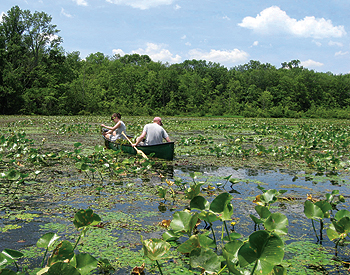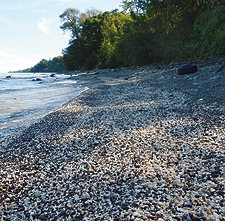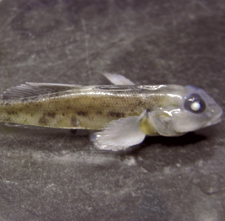WPC Gains Tool in Invasive Species Management

Thick mats of invasive water chestnut choke Lake Towhee in Haycock Township, Photo courtesy of Bucks County Conservation District
At first glance, the rooted aquatic plant looks innocent; its floating leaves look glossy and fan-shaped and arrange themselves in large floating rosettes. In mid- to late-July, a delicate white flower emerges from the center of the rosette.
But in short order, this annual plant with long, cord-like stems and spiny submerged fruits can take over a lake or a pond with its dense floating mats, making it look more like a field of greenery than a body of water. The invasive water chestnut (Trapa natans) chokes out native plants, affecting the ecosystem of the watershed. It can make recreational activities like boating and fishing nearly impossible.
The Western Pennsylvania Conservancy has long played a role in the managing and monitoring of invasive aquatic species like the water chestnut. And now it has a new weapon.
The Conservancy, through its role in the Pennsylvania Natural Heritage Program, provides scientific information, expertise and assistance to support the conservation of biological diversity. And now it’s also taking the lead to develop the Pennsylvania node of iMapinvasives. The Pennsylvania iMapinvasives project is an online tool for tracking invasive species. The geographic information system-based data management tool enables not only natural resource managers, but also citizens, to join the effort to stop invasive species.
The iMapInvasives tool is a reporting and inventory system that allows participants in Pennsylvania to track the location of an invasive species as well as include additional information in the form of assessments, surveys, and treatments. The database will also help identify emerging new threats.
In March, the iMapInvasives website went live, allowing public access to the website and its database. Since then, Conservancy staff members have been conducting presentations and trainings, showing citizens and natural resource managers how to enter observation data and navigate the website.
Already, the iMapInvasives database has more than 1,800 observation records with many more waiting to be entered.
“Invasive species information is currently scattered among state agencies, land managers, volunteer efforts and others. By bringing together invasive information in iMapInvasives we can get a handle on the scope of the infestations, prioritize new surveys and treatments, and identify important species to watch. We expect to improve management of invasive species and hope to influence policy decisions about them,” said Mary Walsh, a WPC aquatic ecologist who manages the project.
In the course of their search for rare native species, Heritage biologists often encounter and record exotic invasive species observations. As iMapInvasives develops, information from past and current surveys will be incorporated into the iMapInvasives database.
Work on the tracking tool continues thanks to financial support from the Great Lakes Restoration Initiative, provided through the Pennsylvania Fish and Boat Commission.
“It’s important to note that someone doesn’t have to be an expert in invasive species to be a part of this project. They just have to care about protecting native ecosystems,” said Amy Stauffer, an invasive species information assistant at the Conservancy.
At the website (www.iMapInvasives.org/paimi), users can watch a training video and get started. New users complete a short form to request a login.

Photo courtesy of Sara Grisé-Stahlman, PA Sea Grant
Zebra Mussels
Native to Russia, zebra mussels (Dreissena polymorpha) were introduced to North America in the mid-1980s, likely by being transferred in ships’ ballast water. Zebra mussels attach themselves to native mussels, making the latter vulnerable to environmental stressors such as parasites, disease and lack of food. As a result, native mussels that were once common throughout the coastal waters of the Great Lakes have suffered population declines.
While it’s illegal to transport zebra mussels, people carry the mussels from lake to lake on boating, diving and fishing equipment without even knowing it. The zebra mussel can survive outside water for days and adults attach themselves to items such as boat hulls.

Round Goby
The round goby (Neogobius melanostomus) is a bottom-dwelling, invasive fish that competes with and preys on native species. It outcompetes native species for food, nesting and shelter and voraciously eats the eggs of native fish.
According to the U.S. Geological Survey, the round goby was first reported in Pennsylvania in 1996 and was later found in Lake Erie and its tributaries. Like the zebra mussel, the round goby probably spread to the Great Lakes from the Black Sea via ships’ ballast water. They eat zebra mussels, so that available food source might have helped the population grow, according to the USGS.
Get Involved
You can help WPC by volunteering your time! Click here to learn more.
